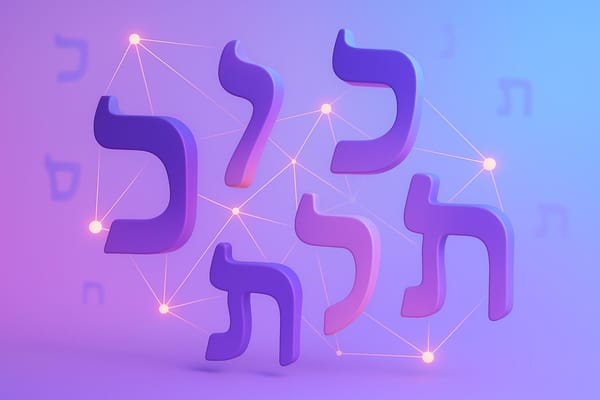Hebrew Gender Rules: Complete Beginner's Guide
Understanding Hebrew gender rules is essential for correct sentence formation, affecting nouns, adjectives, verbs, and pronouns.

Every word in Hebrew has a gender. Whether you're talking about people, objects, or ideas, nouns, adjectives, verbs, and pronouns must match in gender to form correct sentences. Here's a quick breakdown of the essentials:
- Nouns: Masculine nouns often have no specific ending, while feminine nouns typically end in -ה (-ah) or -ת (-t). Example: שולחן (shulchan, table) is masculine, חנות (chanut, store) is feminine.
- Adjectives: Must agree with the noun's gender. Example: סוס גדול (soos gadol, big horse) vs. סוסה גדולה (soosa gdola, big mare).
- Verbs: Conjugate differently for masculine and feminine subjects. Example: הוא קורא (hu kore, he reads) vs. היא קוראת (hi koret, she reads).
- Pronouns: Adjust based on the gender of the subject. Example: הוא (hu, he) vs. היא (hi, she).
Quick Tip:
- Feminine plural nouns often end in -ות (-ot), while masculine plural nouns end in -ים (-im). Example: סוסים (soosim, horses, masc.) vs. סוסות (soosot, mares, fem.).
Why it matters: Gender agreement is critical to mastering Hebrew grammar. Start by practicing noun-adjective pairs and verb conjugations to build confidence.
This guide covers everything you need to know about gender rules in Hebrew, from identifying noun genders to mastering verb and pronoun agreements. Let’s dive in!
Gender and Plural: Hebrew Basics #2
How Nouns Work with Gender in Hebrew
Nouns are a key part of Hebrew grammar, and understanding their gender is essential for grasping the language's structure.
Identifying Masculine and Feminine Nouns
In Hebrew, masculine nouns usually don't have specific endings in their singular form and take the -ים (-im) ending for plurals. For example, סוס (soos, horse) becomes סוסים (soosim, horses). Feminine nouns, on the other hand, often end with -ה (-ah) or -ת (-t) and form plurals with -ות (-ot). For instance, סוסה (soosa, mare) becomes סוסות (soosot, mares).
Irregular Nouns and Exceptions
Some nouns don't follow the typical gender rules:
| Category | Example | Translation | Notes |
|---|---|---|---|
| Body Parts in Pairs | יד (yad) | hand | Feminine despite lacking a feminine ending |
| Family Terms | אמא (ima) | mother | Feminine even though the ending isn't standard |
Quick Reference: Noun Endings by Gender
| Gender | Common Endings | Example | Translation |
|---|---|---|---|
| Feminine | -ה (-ah) | משפחה (mishpaha) | family |
| Feminine | -ת (-t) | רכבת (rakevet) | train |
| Feminine | -ות (-ot) plural | משפחות (mishpahot) | families |
| Masculine | No specific ending | מלך (melech) | king |
| Masculine | -ים (-im) plural | מלכים (melachim) | kings |
For biological gender, Hebrew uses words like זכר (zachar, male) and נקבה (nekeva, female), though these terms are rarely applied to people [4].
Now that we've covered noun gender, let's look at how adjectives follow these patterns to ensure proper agreement.
How Adjectives Match Gender in Hebrew
In Hebrew, adjectives change form to align with the gender and number of the noun they describe. This ensures proper agreement between the noun and its modifier.
Rules for Matching Adjectives to Nouns
Adjectives in Hebrew follow clear guidelines based on the noun's gender and number. For masculine singular nouns, adjectives often have no specific ending or end in -י. Feminine singular adjectives typically end in -ה, -ת, or -ית [1].
| Noun Type | Adjective Ending | Example | Translation |
|---|---|---|---|
| Masculine Singular | No ending/י | סוס גדול | big horse |
| Feminine Singular | ה/ת/ית | סוסה גדולה | big mare |
| Masculine Plural | ים- (for plurals) | סוסים גדולים | big horses |
| Feminine Plural | ות- (for plurals) | סוסות גדולות | big mares |
Examples of Adjective-Noun Agreement
Examples such as חנות גדולה (hanot gdola - big store) and מכונית טובה (mehonit tova - good car) illustrate how adjectives adjust to match feminine nouns [1].
For nouns with irregular endings, the adjective must correspond to the noun's actual gender, not just the ending [4].
The main takeaway: adjectives in Hebrew always reflect the gender and number of the noun they describe.
Next, we'll look at how gender affects Hebrew verb conjugations.
How Gender Affects Hebrew Verbs
Hebrew verbs follow gender-based rules, just like nouns and adjectives. These changes ensure consistency throughout the language and apply to all tenses, making the verb system predictable once you understand the patterns.
Present Tense Verb Forms by Gender
In the present tense, Hebrew verbs adjust depending on the subject's gender. For example, the verb "to read" (קורא) changes as follows: הוא קורא (hu kore, he reads) becomes היא קוראת (hi koret, she reads) [1].
| Subject | Hebrew | Transliteration | English |
|---|---|---|---|
| He | הוא קורא | hu kore | he reads |
| She | היא קוראת | hi koret | she reads |
| They (m) | הם קוראים | hem kor'im | they read |
| They (f) | הן קוראות | hen kor'ot | they read |
Gender in Past and Future Verb Forms
Gender distinctions in Hebrew verbs are also noticeable in past and future tenses [2].
Past Tense Examples:
- Masculine: אמר (amar - he said)
- Feminine: אמרה (amra - she said)
Future Tense Examples:
- Masculine: יאמור (ya'amor - he will say)
- Feminine: תאמר (ta'amer - she will say)
Quick Guide: Verb Conjugations by Gender
The table below summarizes gender-based conjugations for the verb "to say" (לאמור):
| Tense | Person | Masculine | Feminine |
|---|---|---|---|
| Past | 2nd Person Singular | אמרתָ (amarta) | אמרתְ (amart) |
| Past | 3rd Person Singular | אמר (amar) | אמרה (amra) |
| Future | 2nd Person Singular | תאמור (ta'amor) | תאמרי (ta'amri) |
| Future | 3rd Person Singular | יאמור (ya'amor) | תאמר (ta'amer) |
Although it may seem intricate at first, these patterns are consistent across different verbs [1][2].
Next, we’ll look at how gender impacts pronouns in Hebrew, adding another layer to the language's structure.
Using Pronouns with Gender in Hebrew
In Hebrew, pronouns are closely tied to gender, influencing personal, possessive, and demonstrative forms. Understanding these distinctions is crucial for clear communication.
Personal Pronouns by Gender
Personal pronouns in Hebrew change based on gender and number, except for אני (ah-nee, "I") and אנחנו (anachnu, "we"), which are gender-neutral:
| Person | Masculine | Feminine | Pronunciation (M/F) |
|---|---|---|---|
| You (singular) | אתה | את | ah-tah / aht |
| He/She | הוא | היא | hu / hi |
| You (plural) | אתם | אתן | ah-tehm / ah-tehn |
| They | הם | הן | hem / hen |
How Possessive Pronouns Match Gender
Possessive pronouns in Hebrew adjust to reflect the gender of the owner. These forms are commonly used to indicate possession or relationships:
| Owner | Possessive Form | Pronunciation | English |
|---|---|---|---|
| Male owner | שלו | shelo | his |
| Female owner | שלה | shela | her |
| Male group | שלהם | shelahem | their (m) |
| Female group | שלהן | shelahen | their (f) |
Examples include הספר שלו (hasefer shelo, "the book is his") and הספר שלה (hasefer shela, "the book is hers") [1][2].
Demonstrative Pronouns in Masculine and Feminine Forms
Demonstrative pronouns in Hebrew also differ based on gender:
| Distance | Masculine | Feminine | Pronunciation (M/F) |
|---|---|---|---|
| This/That | זה | זאת | zeh / zot |
| These/Those | אלה | אלו | eleh / elu |
Correct usage examples:
- זה ספר (zeh sefer) - "this is a book" (masculine)
- זאת מחברת (zot machberet) - "this is a notebook" (feminine)
Grasping these pronoun rules is a vital step in understanding Hebrew's gendered structure, setting you up for smoother communication [1][2][3].
Tips for Learning Hebrew Gender Rules
Mastering Hebrew gender rules takes consistent effort and smart strategies. Below are practical tips to help you get a handle on this essential part of the language.
How to Remember Gendered Words
Struggling to remember which words are masculine or feminine? Try these techniques:
- Use color-coding in your notes (e.g., blue for masculine, pink for feminine).
- Group words by common gender endings, like 'ה' and 'ת' for feminine nouns.
- Create digital flashcards with categories for each gender.
- Record yourself saying gendered words and listen to them during your daily routine.
These methods can help you build stronger associations and recall gendered words more easily.
Practice Exercises for Gender Agreement
Regular practice is key to getting comfortable with gender rules. Here are some effective exercises:
| Exercise Type | Description | Example |
|---|---|---|
| Noun-Adjective Matching | Pair nouns with adjectives that match in gender | הסוסה הגדולה (hasusa hagdola) → "the big mare" |
| Verb Conjugation | Conjugate verbs for masculine and feminine subjects | היא הולכת (hi holechet) → "she walks" |
| Sentence Building | Create sentences with proper gender agreement | הסוסה הגדולה רצה (hasusa hagdola ratza) → "the big mare runs" |
These exercises will help you internalize the rules and use them naturally in conversation.
Common Mistakes and How to Avoid Them
Here are some frequent pitfalls and tips to steer clear of them:
- Noun Gender Recognition: Irregular nouns and borrowed words can be tricky. Use reliable reference materials to double-check their gender.
- Verb Agreement: Always match the verb to the subject's gender. Practice conjugating verbs for both masculine and feminine subjects, and review past and future tenses often.
- Adjective Matching: Adjectives need to match both gender and number. Double-check your endings and consult reference materials if you're unsure.
To stay on track, use language apps and online tools, but make sure you get regular feedback from native speakers or experienced instructors. This helps you catch mistakes early and form good habits as you learn.
Summary and Next Steps
Key Points to Remember
Hebrew's gender system plays a role in how nouns, adjectives, and verbs are used. Feminine nouns typically end in ה or ת, while masculine nouns don't follow a specific pattern. Plural forms and adjective agreement stick to predictable rules. Grasping these basics is crucial for effective communication in Hebrew.
To build on these rules, take advantage of tools that make learning Hebrew easier:
Helpful Tools and Resources
| Tool | Key Feature |
|---|---|
| baba | Provides real-time translation with gender detection |
| HebrewPod101 | Offers structured lessons for all skill levels |
| Easy Learn Hebrew | Focuses on mastering Hebrew letters |
These resources can help you strengthen your understanding and practice using gender rules in Hebrew.
What to Do Next in Your Hebrew Learning
Learning the rules is just the beginning. Here's how to put them into practice:
- Practice gender rules daily for 5 minutes [3].
- Watch Israeli shows with subtitles to observe gendered forms in real conversations [4].
- Use language exchange apps to chat with native speakers and apply what you've learned [4].
Keep in mind that learning Hebrew gender rules takes time. Start with the basics, practice consistently, and gradually tackle more complex structures. Over time, gender agreement will feel more natural and automatic in your Hebrew conversations.





